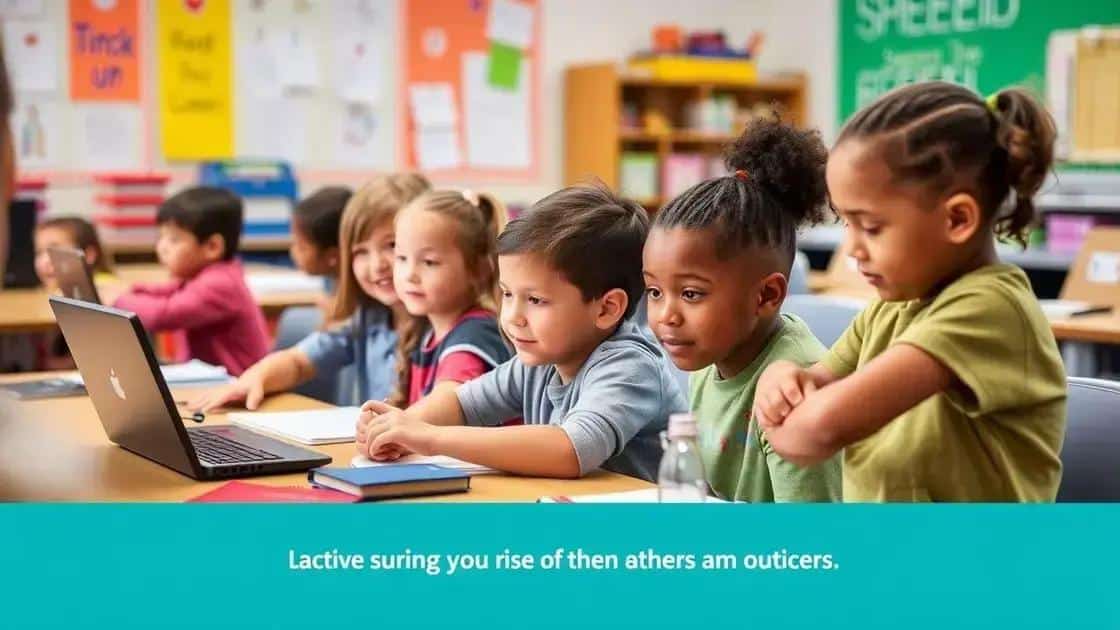Challenge early childhood learning: Unlocking potential

Effective early childhood learning relies on innovative strategies such as play, parental involvement, and technology integration to engage children and foster their cognitive and emotional development.
Challenge early childhood learning is essential for fostering a supportive environment that promotes growth. What if the way we approach learning could transform the early years? Let’s dive into effective methods to support our youngest learners.
Understanding the challenges in early childhood learning
Understanding the challenges in early childhood learning is crucial for creating an effective educational experience. Children face various obstacles as they grow, and identifying these challenges can significantly enhance their learning outcomes.
One major challenge is access to quality education. Not all children have the same opportunities, often due to socioeconomic factors. This discrepancy can lead to gaps in knowledge and skills early on.
Cognitive Development Issues
Cognitive development is another area where children may struggle. Some might find it difficult to grasp basic concepts, while others may not engage effectively. Recognizing these differences allows educators to tailor their approaches to meet individual needs.
- Frequent behavioral issues can stem from unmet cognitive needs.
- Teachers can foster a supportive environment by adjusting learning activities.
- Utilizing visual aids helps many children process information better.
Additionally, social and emotional development plays a vital role. Children who have trouble interacting with peers may face challenges in expressing themselves. Building strong relationships through play and constructive interactions can help mitigate these difficulties.
Incorporating family support is essential for overcoming these challenges. When parents are involved in their child’s education, it creates a bridge that enhances learning. This support can take many forms, such as reading together at home or participating in school events.
Creating Inclusive Learning Environments
To tackle the challenges in early childhood learning, creating inclusive environments is key. Classrooms that celebrate diversity enable children to feel accepted and understood. This approach fosters a love for learning and builds their confidence.
- Inclusion promotes awareness and respect among children.
- Teachers trained in inclusive practices can address various learning styles.
- Utilizing diverse resources helps cater to different backgrounds.
All these factors combined highlight the importance of recognizing and addressing the challenges in early childhood learning. By focusing on these aspects, we can pave the way for a brighter future for every child.
The importance of play in learning
The importance of play in learning cannot be overstated. Play is a natural way for children to explore their world and develop new skills. Through play, children can learn critical thinking, social skills, and creativity.
Engaging in play also helps children process their emotions. When they use their imagination, they can express thoughts and feelings they might not be able to articulate otherwise. This process is vital for emotional development.
Types of Play
There are different types of play that support various aspects of learning. Each type plays a unique role in promoting development.
- Creative play involves activities like drawing, building, or role-playing, allowing children to express their creativity.
- Constructive play encourages problem-solving as kids build structures or create things with different materials.
- Physical play boosts fine and gross motor skills and helps children understand their physical limits.
These forms of play are not just fun; they are essential for a child’s overall development. Engaging with others during playtime also enhances social skills. Children learn how to take turns, share, and communicate effectively, laying the foundation for their future interactions.
Play as a Learning Tool
Teachers can harness the power of play as a learning tool in the classroom. By integrating structured play into the curriculum, educators can make learning more engaging. For example, incorporating games and hands-on activities into lessons can make concepts easier to understand.
Additionally, play allows for individualized learning experiences. Children can explore subjects at their own pace and according to their interests. This flexibility helps to foster a love for learning, as children feel empowered to discover on their own terms.
Moreover, parents are encouraged to incorporate play at home. Simple activities like storytelling, puzzles, and outdoor games can enhance your child’s educational journey. Overall, recognizing the significance of play in learning is essential for nurturing well-rounded individuals.
Strategies to engage children effectively

Strategies to engage children effectively are essential for promoting a productive learning environment. When children are actively involved, their potential for learning increases significantly. Various techniques can help educators capture the attention of young learners.
One effective strategy is to incorporate hands-on activities. These activities allow children to explore concepts through direct experience, making learning fun and memorable. Whether it’s science experiments, art projects, or interactive games, active participation fosters curiosity and retention of knowledge.
Utilizing Technology
Integrating technology into the classroom can also boost engagement. Interactive educational software, apps, and online resources provide dynamic learning experiences. Children can explore subjects at their own pace, enhancing their understanding and enthusiasm.
- Interactive games can reinforce learning while keeping students entertained.
- Virtual field trips allow students to visit places they may never see in person.
- Online quizzes and activities make assessment enjoyable and engaging.
Another strategy is to use storytelling to capture children’s imaginations. Stories connect lessons to real-life scenarios, making concepts relatable. When children see themselves in stories, they are more likely to engage with the material.
Group Activities
Group activities are also a valuable method for enhancing engagement. Working together promotes collaboration and teamwork. Children learn from each other and develop social skills that are crucial for their growth.
Incorporating movement into lessons can also keep children attentive. Activities such as brain breaks or kinesthetic learning engage children physically and mentally, making lessons more effective. Additionally, fostering an environment where children can ask questions and explore can lead to deeper learning. When children feel comfortable expressing their thoughts, they are more likely to participate.
Overall, employing these strategies can make a significant difference in engaging children effectively. By prioritizing their interests and promoting active participation, educators can create a more responsive and enriching learning experience.
Role of parents in early education
The role of parents in early education is crucial for a child’s development and learning journey. When parents are actively involved, children are more likely to succeed in school and develop a love for learning. This engagement sets the stage for their future educational experiences.
One significant way parents can contribute is by creating a supportive home environment. When children feel safe and encouraged, they are more likely to explore new ideas and express their thoughts. This nurturing atmosphere helps foster their confidence and curiosity.
Encouraging Learning at Home
Parents can encourage learning at home by integrating educational activities into daily routines. Simple actions like reading together, playing educational games, or involving children in cooking can enhance their cognitive skills. These activities not only promote learning but also strengthen family bonds.
- Reading regularly boosts vocabulary and comprehension skills.
- Hands-on activities help solidify math and science concepts.
- Encouraging questions promotes critical thinking and exploration.
Moreover, being involved in school activities can significantly impact a child’s educational journey. Parents who attend school events, volunteer in classrooms, or communicate with teachers show their children that education is a priority. This involvement helps children feel valued and supported.
Modeling Positive Attitudes
Another key aspect of parental involvement is modeling a positive attitude towards learning. When parents express enthusiasm for education and lifelong learning, children are more likely to mirror these behaviors. This can be as simple as discussing interesting facts, sharing experiences, or showing excitement during learning activities.
Additionally, open communication between parents and children is vital. Encouraging children to share their thoughts and feelings about school helps them process their experiences. When parents listen and validate their children’s feelings, it fosters emotional intelligence and resilience.
Ultimately, the role of parents in early education cannot be understated. Through active participation, support, and positive modeling, parents can significantly influence their child’s educational path and help develop a strong foundation for future success.
Innovative approaches to enhance learning experiences
Innovative approaches to enhance learning experiences are essential for keeping children engaged and inspired. Education is evolving, and incorporating new methods can make learning more effective and enjoyable.
One popular approach is using project-based learning. This method encourages students to explore real-world problems and challenges. Students work on projects that require critical thinking, creativity, and collaboration. As they engage with the material, they develop a deeper understanding of the subject matter.
Gamification in Learning
Another effective strategy is gamification. By integrating game elements into lessons, teachers can make learning fun and competitive. This can include earning points, achieving badges, or completing challenges. Gamification can motivate students and encourage them to participate actively in their education.
- Rewards systems can boost motivation and effort.
- Learning through play can enhance skill development.
- Friendly competition can foster teamwork and collaboration.
Incorporating technology is also a vital part of modern learning. Using tools like tablets, interactive whiteboards, and educational apps can create interactive and personalized experiences. Technology caters to different learning styles and helps students learn at their own pace.
Flipped Classrooms
The flipped classroom model is gaining popularity as well. In this approach, students learn new content at home, usually through videos, and engage in hands-on activities in the classroom. This method allows teachers to focus on guidance and support during class time, making learning more interactive and student-centered.
Finally, fostering a growth mindset encourages students to embrace challenges. Teaching them that effort and perseverance lead to improvement can transform how they view learning. By celebrating mistakes and viewing them as opportunities to grow, students become more resilient.
Overall, these innovative approaches can create dynamic learning environments that cater to the needs of all students, ensuring they receive the most enriching educational experiences possible.
FAQ – Questions About Early Childhood Learning Strategies
What is the role of parents in early childhood education?
Parents play a vital role by actively participating in their child’s education and creating a supportive home environment that fosters learning.
How does play contribute to a child’s learning?
Play enhances cognitive and emotional skills, allowing children to explore concepts in a fun and engaging way, which promotes deeper understanding.
What are innovative strategies for engaging children in learning?
Innovative strategies include project-based learning, gamification, and technology integration, all of which make learning interactive and personalized.
Why is a growth mindset important in education?
A growth mindset encourages children to embrace challenges and view mistakes as opportunities for learning, fostering resilience and a positive attitude.






